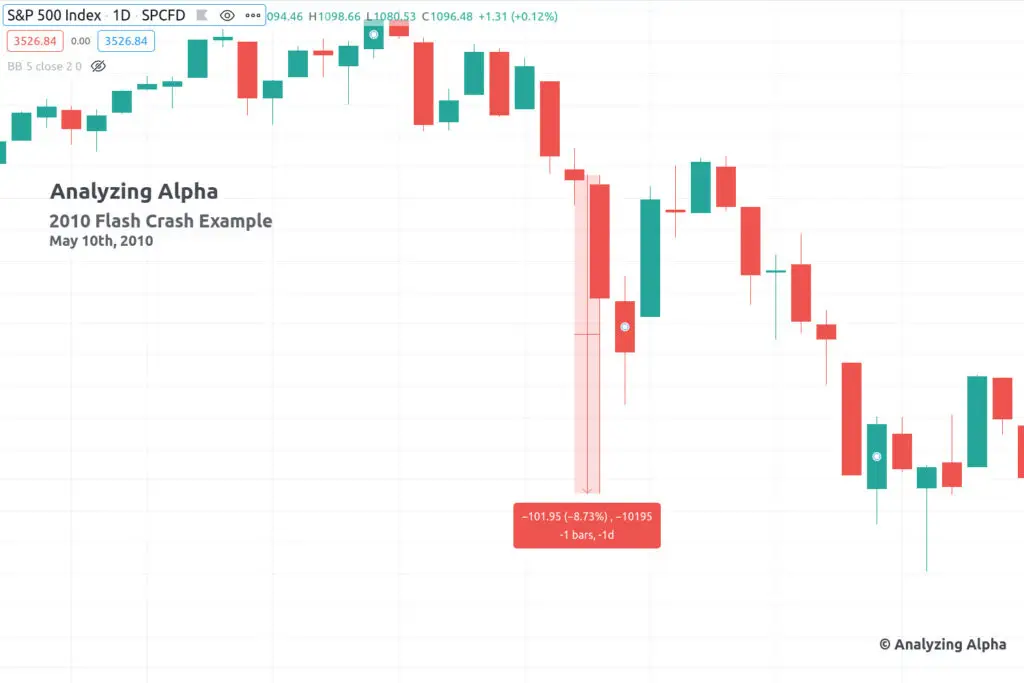Stock market circuit breakers, also known as trading curbs, are temporary measures that automatically halt trading when dramatic stock market declines occur. Circuit breaker levels halt trading when the S&P 500 index drops 7%, 13%, and 20% from the previous day’s closing price.
Declines sufficiently dramatic to trigger stock market circuit breakers are relatively rare. The problem is that when they do occur, it’s during times of panic.
The better you understand stock market circuit breakers, the better you can keep a cool head when they’re triggered and trade profitably around these market interruptions.
What Are Market Circuit Breakers?
Stock market circuit breakers are a way to halt trading during extreme market declines in US stock markets. Trading automatically halts once the stock market drops a certain amount compared to the previous day’s closing price.
Halting trading aims not to stop a proper correction but to avoid a panic-driven selling spree. The first two of the three circuit breaker levels last only fifteen minutes. This is not so long that people genuinely intent on selling will rethink their positions, but it can limit the panic-based responses to dropping prices.
Additionally, stock market circuit breakers exist to curb the influence of a flash crash or other technology-driven sell-off. While technology in trading provides numerous benefits to many traders, it also comes with risks. The automated nature of modern trading means that unintentional sell-offs may suddenly occur.
For example, when prices drop, this could trigger a computer algorithm to tell the computer it needs to sell. If enough algorithms sell at this same level, this could drive the price down, which could trigger the next level of sell-offs, and so on, creating a cascading wave of sell-offs that leads to sudden massive market declines.
This algorithmic-driven sell-off caused the May 6, 2010 flash crash seen below.

Market Circuit Breaker Levels
Stock market circuit breaks in the US have three distinct thresholds. It’s essential to understand each level because not all levels halt trading for the same length of time.
Level 1 halts trading for 15 minutes when the stock market sees a single-day decline of 7% from the previous day’s closing price before 3:25 pm Eastern. The market will only halt at 3:25 or later with a level 3 halt, discussed below.
Level 2 occurs for 15 minutes if a decline of 13% happens before 3:25 pm after a level 1 halt concludes.
Level 3 halts trading when there is a decline of 20%. This applies regardless of what time the threshold is reached. For markets to reach this threshold before 3:25 pm, they must have hit level 1, halted for 15 minutes, dropped to 13% once trading recommenced, halted for another 15 minutes, and finally dropped again, all the way to 20%. As you can imagine, reaching a level 3 circuit breaker trigger is hard.
In fact, in its modern form, a level three circuit breaker has not been triggered during regular trading hours.
| Level | Decline & Time | Action |
|---|---|---|
| Level 1 | 7% decline before 3:25 pm | Halt 15 minutes |
| Level 2 | 13% decline before 3:25 pm | Halt 15 minutes |
| Level 3 | 20% decline anytime | Halt the remainder of the day |
Circuit Breakers vs. Individual Stock Price Bands
Before we go any further, it’s essential to differentiate between market circuit breakers and the Limit Up-Limit Down Rule that places price bands around individual stocks and ETFs.

Single stock price bands work similarly to stock market circuit breakers because they halt trading should panic-driven sell-offs occur, but there are some noticeable differences. First, the thresholds that halt trading for a specific stock or ETF vary depending on the security in question, the stock or ETF’s share price, and the time of day.
As the name implies, these thresholds apply to both upward and downward movement instead of the circuit breakers for the US stock market, which are only triggered by declines.
Finally, the halts placed on individual stocks or ETFs are usually considerably shorter than stock market halts. Typically, trading suspensions on individual stocks and ETFs last only five minutes. Halts on individual stocks and ETFs are more common than a market halt.
Individual Security Circuit Breaker Levels
| 9:30 – 9:45am and 3:35-4:00pm | 9:45am – 3:35pm | Listing | Price |
|---|---|---|---|
| 10% | 5% | NMS Tier 1: Stocks included in the S&P 500, Russell 1000, and select exchange-traded products.s | Price greater than $3.00 |
| 20% | 10% | NMS Tier 2: Contains all other NMS stocks. | Price greater than $3.00 |
| 40% | 20% | OTCE: Contains all Over-the-Counter equity securities. | Price less than $3.00 and greater than $0.75. |
| Lesser of 150% (upper limit only) or $0.30 | Lesser of 75% or $0.15 | OTCE: Contains all Over-the-Counter equity securities. | Stocks priced less than $0.75. |
You can learn more about Limit Up / Limit Down and OTC Transparency if you’re interested.
Futures Circuit Breakers — Price Limits
Futures markets have daily up-and-down fluctuation limits, also known as price limits. These limits are similar to the price bands for individual securities.
If the futures are bid to the upper limit, they’re said to be “limit up”. Trades are allowed to be placed at this upper limit but no further.
The same goes for the downside. If futures are bid to the lower limit, they’re said to be “limit down”. Trades can be placed at this limit but no further.
Futures are traded around the clock with a 30-minute pause each evening. From 9:30 am to 3:25 pm, the limits are equivalent to the market circuit breaker levels discussed above during regular trading hours.
- Level 1 – 7%
- Level 2 – 13%
- Level 3 – 20%+
Outside of regular trading hours, there are 5% up-and-down limits.
The History of Stock Market Circuit Breakers
Stock market circuit breakers only came about a little over thirty years ago.

On October 19, 1987, the Dow Jones Industrial Average (DJIA) dropped 22.6% in one day. The crash became known as Black Monday, and it led to regulators putting in place the first-ever stock market circuit breakers.
But the circuit breakers back in the 1980s look pretty different than they do today. That’s because regulators continue to update the circuit breakers to better cope with the market changes, which are usually heavily driven by technology.
For example, a flash crash occurred on May 6, 2010, leading to a 9% decline in the DJIA in only ten minutes. The speed at which the fall occurred kept the circuit breakers from halting trading. Though prices mostly returned to their pre-crash prices by the end of that same day, the problem of future flash crashes remained, and regulators updated the circuit breakers to avoid another flash crash.
You’ll notice that both the creation of circuit breakers and subsequent updates occurred retroactively. Meaning only after major crashes occurred were safeguards put in place. Current circuit breakers may keep any future crashes from happening, but it’s also possible that the evolution of the markets and new technology may create another crash under different circumstances.
What Can Traders Do During a Trading Halt?
If you’re a trader during a time of significant market movement and you can’t place trades, what exactly should you do?
Like an electrical circuit breaker, a stock market circuit breaker attempts to allow time for things to cool off – take advantage of the halt in trading.
Data-based, thoughtful decisions will almost certainly pay off more in the long run than panic-driven selling. While we all know this on an intellectual level, it’s far harder to act rationally when you’re watching stocks dive. A halt in trading is an excellent opportunity to catch your breath and decide on your next move. A key consideration is the time frame you’re working with.
If you’re a day trader, the high levels of volatility may provide opportunities. If you’re a long-term investor, the volatility of a single day may have little to no impact on your trading decisions.
Is a Trading Halt Good or Bad?
As we’ve seen, both market and security circuit breakers’ goal is to halt trading and give investors time to cool off during emotional sell-offs. But does it work?

On its surface, the idea makes sense, but as with almost any financial theory, it has its detractors. Mason Gerety, a former SEC research economist and current professor emeritus at Northern Arizona University, researched circuit breakers in the 1990s and found an area of concern. According to his research, when sellers think a circuit breaker will kick in, they’ll sell more quickly. This could cause more and faster selling, the exact opposite of the intent of circuit breakers.
Other analysts view circuit breakers as disruptive and argue that circuit breakers add a level of volatility to the stock market that would not otherwise exist. Their belief is that circuit breakers cause traders to place orders at the limit level and decrease liquidity. These critics think the market would see less overall volatility if no halts occurred.
Stock Market Circuit Breakers in 2020
Stock market circuit breakers may be more front of mind than in years past since earlier in 2020, the US markets saw an unprecedented four circuit breakers triggered in a mere matter of weeks.
All four of the 2020 declines that triggered stock market circuit breakers occurred due to the growing international concern over the COVID-19 pandemic. The first three circuit breaker triggers happened in the opening hours of March 9, March 12, and March 16. The final circuit breaker trigger occurred on March 18, but it happened later in the day, unlike the other three.
Though the market saw sufficient declines to trigger trading halts four times, each time led only to a level one halt. After a 15-minute halt, the stock market did not continue to fall far enough to hit the next threshold. The argument could be made that the circuit breaker did its job and limited panic-driven selling, but it’s also possible that the decline would have reached the same level whether the circuit breakers were triggered. Ultimately, whether the drop failed to go even further because of the circuit breakers or not is impossible to know.
The Bottom Line
Whether or not you think circuit breakers help or hurt the stock market, they’re part of trading, and the better you understand them, the better chance you have of keeping a level head when panic erupts in the market and making profitable trades.